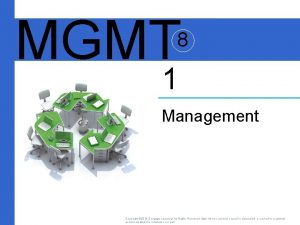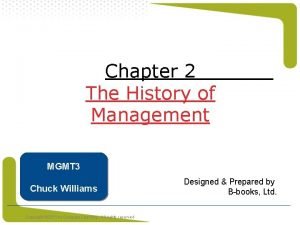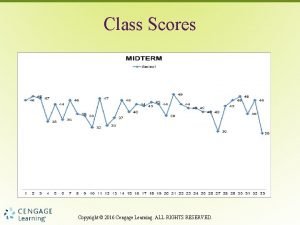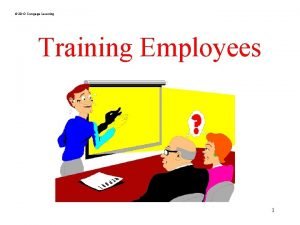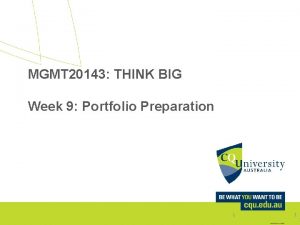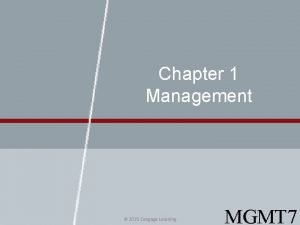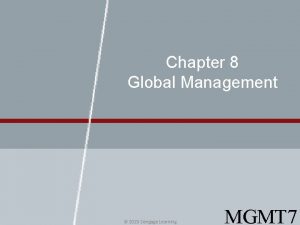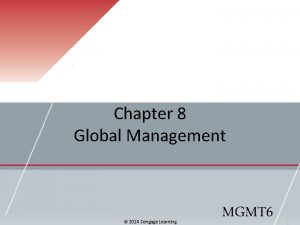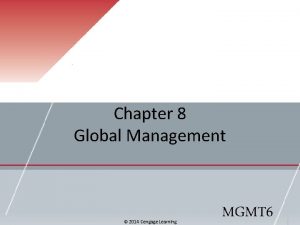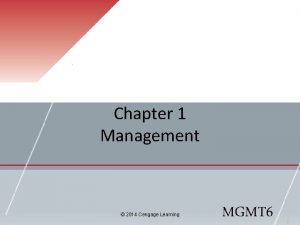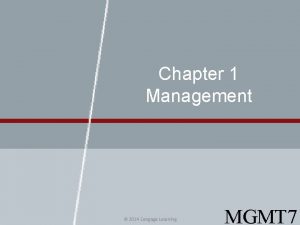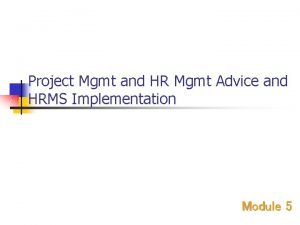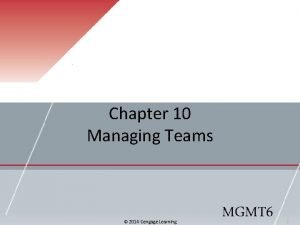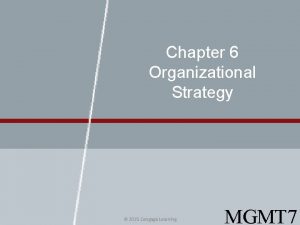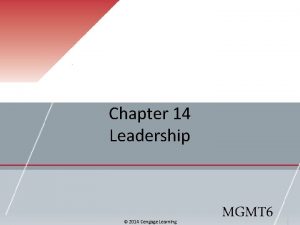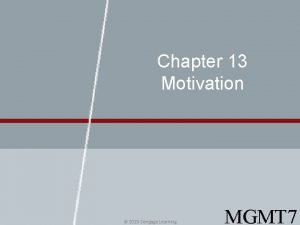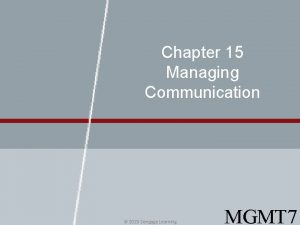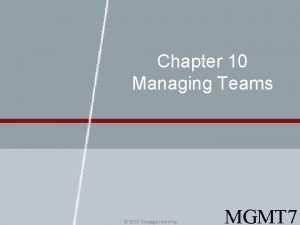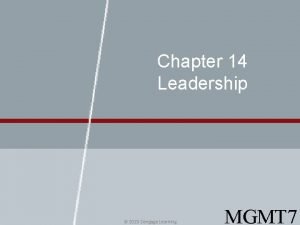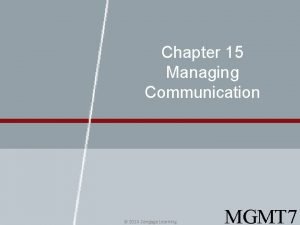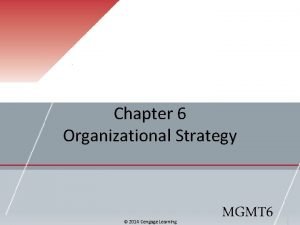MGMT 8 1 Management Copyright 2016 Cengage Learning






























- Slides: 30

MGMT 8 1 Management Copyright © 2016 Cengage Learning. All Rights Reserved. May not be scanned, copied or duplicated, or posted to a publicly accessible website, in whole or in part.

LEARNING OUTCOMES 1 Describe what management is 2 Explain the four functions of management 3 Describe different kinds of managers 4 Explain the major roles and subroles that managers perform in their jobs 5 Explain what companies look for in managers Copyright © 2016 Cengage Learning. All Rights Reserved. May not be scanned, copied or duplicated, or posted to a publicly accessible website, in whole or in part. MGMT 8 | CH 1 2

LEARNING OUTCOMES 6 Discuss the top mistakes that managers make in their jobs 7 Describe the transition that employees go through when they are promoted to management 8 Explain how and why companies can create competitive advantage through people Copyright © 2016 Cengage Learning. All Rights Reserved. May not be scanned, copied or duplicated, or posted to a publicly accessible website, in whole or in part. MGMT 8 | CH 1 3

Management Is… Getting work done through others Efficiently Effectively 4 Copyright © 2016 Cengage Learning. All Rights Reserved. May not be scanned, copied or duplicated, or posted to a publicly accessible website, in whole or in part. MGMT 8 | CH 1 4

Management • Getting work done through others • Efficiency: Getting work done with minimum effort, expense, or waste • Effectiveness: Accomplishing tasks that help fulfil organizational objectives Copyright © 2016 Cengage Learning. All Rights Reserved. May not be scanned, copied or duplicated, or posted to a publicly accessible website, in whole or in part. MGMT 8 | CH 1 5

The Four Functions of Management © 2015 Cengage Learning 1 -1

Management Functions • Planning • determining organizational goals and a means for achieving them • Organizing • deciding where decisions will be made, who will do what jobs and tasks, and who will work for whom in the company 1 -2 © 2015 Cengage Learning Copyright © 2016 Cengage Learning. All Rights Reserved. May not be scanned, copied or duplicated, or posted to a publicly accessible website, in whole or in part. MGMT 8 | CH 1 7

Management Functions • Leading • inspiring and motivating workers to work hard to achieve organizational goals • Controlling • monitoring progress toward goal achievement and taking corrective action when progress isn’t being made 1 -2 © 2015 Cengage Learning Copyright © 2016 Cengage Learning. All Rights Reserved. May not be scanned, copied or duplicated, or posted to a publicly accessible website, in whole or in part. MGMT 8 | CH 1 8

The Control Process Set standards to achieve goals Make changes to return performance to standards Compare actual performance to standards 2. 4 9 Copyright © 2016 Cengage Learning. All Rights Reserved. May not be scanned, copied or duplicated, or posted to a publicly accessible website, in whole or in part. MGMT 8 | CH 1 9

What the Four Kinds of Managers Do © 2015 Cengage Learning 1 -3

Kinds of Managers • Top managers: Executives responsible for the overall direction of the organization • • Chief executive officer (CEO) Chief operating officer (COO) Chief financial officer (CFO) Chief information officer (CIO) Copyright © 2016 Cengage Learning. All Rights Reserved. May not be scanned, copied or duplicated, or posted to a publicly accessible website, in whole or in part. MGMT 8 | CH 1 11

Kinds of Managers • Middle managers • Responsible for: • Setting objectives consistent with top management’s goals • Planning and implementing subunit strategies for achieving the objectives • Plant manager, regional manager, or divisional manager Copyright © 2016 Cengage Learning. All Rights Reserved. May not be scanned, copied or duplicated, or posted to a publicly accessible website, in whole or in part. MGMT 8 | CH 1 12

Kinds of Managers • First-line managers • Train and supervise the performance of nonmanagerial employees who are responsible for producing a company’s goods and services • Responsibilities - Monitoring, teaching, and short-term planning • Office manager, shift supervisor, or department manager Copyright © 2016 Cengage Learning. All Rights Reserved. May not be scanned, copied or duplicated, or posted to a publicly accessible website, in whole or in part. MGMT 8 | CH 1 13

Kinds of Managers • Team leaders: Managers responsible for facilitating team activities toward goal accomplishment • Help team members: • Plan and schedule work • Learn to solve problems • Work effectively with each other Copyright © 2016 Cengage Learning. All Rights Reserved. May not be scanned, copied or duplicated, or posted to a publicly accessible website, in whole or in part. MGMT 8 | CH 1 14

Mintzberg’s Managerial Roles © 2015 Cengage Learning 1 -4

Managerial Roles • Interpersonal • Figurehead: Managers perform ceremonial duties(welcome visitors, speak at opening of new facilities, support local charities) • Leader: Managers motivate and encourage workers to accomplish organizational objectives • Liaison: Managers deal with people outside their units Copyright © 2016 Cengage Learning. All Rights Reserved. May not be scanned, copied or duplicated, or posted to a publicly accessible website, in whole or in part. MGMT 8 | CH 1 16

Managerial Roles • Informational • Monitor: Managers scan their environment for information • Disseminator: Managers share the collected information with their subordinates and others in the company • Spokesperson: Managers share information with people outside their departments or companies Copyright © 2016 Cengage Learning. All Rights Reserved. May not be scanned, copied or duplicated, or posted to a publicly accessible website, in whole or in part. MGMT 8 | CH 1 17

Managerial Roles • Decisional • Entrepreneur: Managers adapt themselves, their subordinates, and their units to change • Disturbance handler: Managers respond to pressures and problems that demand immediate attention and action • Resource allocator: Managers decide who gets what resources and in what amounts • Negotiator: Managers negotiate schedules, projects, resources, and employee raises Copyright © 2016 Cengage Learning. All Rights Reserved. May not be scanned, copied or duplicated, or posted to a publicly accessible website, in whole or in part. MGMT 8 | CH 1 18

Skills Companies are Looking For Technical skills • Specialized procedures, techniques, and knowledge required to get the job done Human skills • Ability to work well with others Conceptual skills • Ability to: • See the organization as a whole, understand how the different parts affect each other • Recognize how the company fits into or is affected by its environment Motivation to manage • Assessment of how enthusiastic employees are about managing the work of others Copyright © 2016 Cengage Learning. All Rights Reserved. May not be scanned, copied or duplicated, or posted to a publicly accessible website, in whole or in part. MGMT 8 | CH 1 19

Management Skills © 2015 Cengage Learning 1 -5

Exhibit 1. 5 Top Ten Mistakes Managers Make Source: M. W. Mc. Call, Jr. , and M. M. Lombardo, “What Makes a Top Executive? ” Psychology Today, February 1983, 26– 31. Copyright © 2016 Cengage Learning. All Rights Reserved. May not be scanned, copied or duplicated, or posted to a publicly accessible website, in whole or in part. MGMT 8 | CH 1 21

Stages in the Transition to Management © 2015 Cengage Learning 1 -7

Competitive Advantage through People • Stanford University professor contends that what separates top-performing companies from their competitors is the way they treat their work forces-in other words their management. • Managers in top-performing companies develop workforces that a smarter, better, trained, more motivated, and more committed than their competitor’s workforces. 23 Copyright © 2016 Cengage Learning. All Rights Reserved. May not be scanned, copied or duplicated, or posted to a publicly accessible website, in whole or in part. MGMT 8 | CH 1 23

Competitive Advantage Through People • Employment security • Employees can innovate and increase the profitability of an organization without the fear of losing their job • Selective hiring • Companies need to hire the best talent due to the presence of employment security • Self-managed teams • Produce high productivity through increased employee commitment and creativity Copyright © 2016 Cengage Learning. All Rights Reserved. May not be scanned, copied or duplicated, or posted to a publicly accessible website, in whole or in part. MGMT 8 | CH 1 24

Competitive Advantage Through People • Decentralization • Allows employees closest to problems, production, and clients to make timely decisions • High wages contingent on organizational performance • High remuneration helps an organization attract talented employees and retain existing employees • High wages indicates the organization values its employees Copyright © 2016 Cengage Learning. All Rights Reserved. May not be scanned, copied or duplicated, or posted to a publicly accessible website, in whole or in part. MGMT 8 | CH 1 25

Competitive Advantage Through People • Training and skill development • Companies need to invest resources in the training employees to ensure skill development • Reduction of status differences • Leads to employees concentrating on work related issues rather than biases and prejudices of the management • Sharing information • Helps employees participate in the decision making process Copyright © 2016 Cengage Learning. All Rights Reserved. May not be scanned, copied or duplicated, or posted to a publicly accessible website, in whole or in part. MGMT 8 | CH 1 26

SUMMARY • Functions of management are planning, organizing, controlling, and leading • Kinds of managers are top, middle, first-line, and team leaders • Roles played by managers include interpersonal, informational, and decisional • Technical, human, and conceptual skills are essential for managers Copyright © 2016 Cengage Learning. All Rights Reserved. May not be scanned, copied or duplicated, or posted to a publicly accessible website, in whole or in part. MGMT 8 | CH 1 27

KEY TERMS • • • Management Efficiency Effectiveness Planning Organizing Leading Controlling Top managers Middle managers • • • First-line managers Team leaders Figurehead role Leader role Liaison role Monitor role Disseminator role Spokesperson role Entrepreneur role Copyright © 2016 Cengage Learning. All Rights Reserved. May not be scanned, copied or duplicated, or posted to a publicly accessible website, in whole or in part. MGMT 8 | CH 1 28

KEY TERMS • • Disturbance handler role Resource allocator role Negotiator role Technical skills Human skills Conceptual skills Motivation to manage Copyright © 2016 Cengage Learning. All Rights Reserved. May not be scanned, copied or duplicated, or posted to a publicly accessible website, in whole or in part. MGMT 8 | CH 1 29

Copyright © 2016 Cengage Learning. All Rights Reserved. May not be scanned, copied or duplicated, or posted to a publicly accessible website, in whole or in part. MGMT 8| CH 1 30
 Mgmt+8
Mgmt+8 Cengage chapter 7
Cengage chapter 7 Mgmt 11 principles of management
Mgmt 11 principles of management 2009 delmar cengage learning
2009 delmar cengage learning Cengage learning heart diagram
Cengage learning heart diagram Cengage learning heart diagram
Cengage learning heart diagram South-western cengage learning
South-western cengage learning 2009 delmar cengage learning
2009 delmar cengage learning 2009 delmar cengage learning
2009 delmar cengage learning Cengage learning heart diagram
Cengage learning heart diagram Clinical conditions chapter 1 medical terminology
Clinical conditions chapter 1 medical terminology Cengage learning australia
Cengage learning australia 2009 delmar cengage learning
2009 delmar cengage learning Whille
Whille Cengage learning
Cengage learning Wadsworth cengage learning
Wadsworth cengage learning Cengage learning
Cengage learning Cengage learning plant cell
Cengage learning plant cell Cengage learning
Cengage learning Cengage learning
Cengage learning Brooks cole cengage learning
Brooks cole cengage learning Chapter 7:10 respitory system
Chapter 7:10 respitory system 2014 cengage learning accounting answers
2014 cengage learning accounting answers Cengage learning
Cengage learning Cengage learning
Cengage learning 2009 delmar cengage learning
2009 delmar cengage learning Cengage learning
Cengage learning Chapter 10 cultural diversity
Chapter 10 cultural diversity Marketing implications
Marketing implications 2012 cengage learning
2012 cengage learning Training evaluation
Training evaluation
